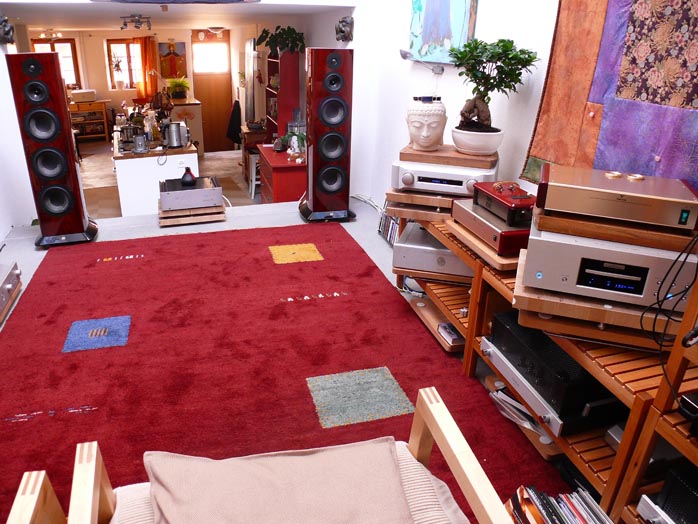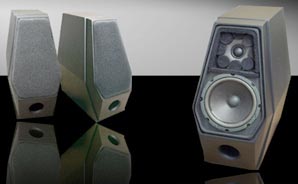This review page is supported in part by the sponsors whose ad banners are displayed below |
 |
 |
LiveLine vs. Entreq: Complete cable loom vs. complete cable loom, it was easy to identify respective house sounds. Particularly swapping back to home base—first LiveLine, then Entreq, then LiveLine again—the distinctions really hit home. First on my base line. As a guitarist with numerous instruments in his collection, Franck Tchang's cable focus is on timing and fully illuminated upper harmonics. The res ultant sound is exceptionally coherent, fast, incisive and on the beat. It's also lit up across the bandwidth and creates a very long staircase into the overtone structures. Slight shifts of tone an advanced player like Biréli Lagrène employs to make his instrument speak with different voices become very acute.
The ASI cable peels back layers of fuzz and cotton wadding and adds no weight or warmth. Timing/phase errors seem low and in speaker terms, we're in Roy Johnson of Green Mountain Audio land: balanced-phase 1st-order networks, physical time alignment, ultra-low cabinet talk from synthetic stone cabinets strategically shaped for minimum diffraction.
|
|
|
To remain with the speaker simile for a second longer, the LiveLine sound is very different from classic Sonus Faber. To those approaching with related expectations, criticisms would include innate leanness, wiriness and a tendency for the sharply accurate. The archetypal toe-tapping trait relates to the LiveLines, albeit not in Naim's earlier relentlessly driven fashion but more relaxed. With Franck Tchang offering only one 'flavor' of cables—the best he knows how to make—and his reference being live music and a personal system around a three-piece dCS stack, Kuzma table, 1200-watt Karan Acoustics class A monos and his own Tango speakers with diamond tweeters, it's fair to say that to fully benefit from his LiveLine cables, a system should be mature enough to not require center-fold air brushing and a soft-focus lens from the cables.
|
 |
Entreq offers various tiers of cables and what I was sent occupies their middle range. The resultant sound remained at the outskirts of the '1st-order' camp but moved into a rather gentler and cozier sector thereof, say vintage Vandersteen. This was softer around the edges, warmer, not as lit up and very billowy or feathery rather than incisive and taut. On Bebo & Cigala's follow-up Blanco y Negro [Calle54 Records, Sony/BMG] where the crayfish performs "La bien pagá" without the Cuban backup singers, there are many truly deep-throated moments by the long-haired Gypsy cantaor. The LiveLines created greater crystallization or edge focus and conveyed more upper harmonic energy. The peaks had one or two more menu stars of chili pepper heat than the mellower Entreqs and the sense of in-room presence was more acute.
|
 |
Naturally, this was a matter of degrees. The sonic key points mostly stayed put. The gestalt was quite different though, with the LiveLines conveying the energetic illusion of 'live' to a rather greater extent. The LiveLines also rendered bass like Javier Colina's upright wirier or more 'gathered'. The Entreqs were bloomier and less tensioned. But the very silent backgrounds for high contrast remained as did the sense of overall cohesion. Highly percussive material like Manu Katché's 3:30-minute drum solo from the Garbarek Group's live Dresden twofer [ECM] had spikier impulses and cracked harder over the LiveLines. This created more dynamic jump and near-field bristle while the same workout felt rounder and more relaxed and farfield with the Discover/Konstantin gang.
|
|
|
Depending on what families of cables one juxtaposed, one could certainly hit upon a more contrarious grouping than ASI and Entreq. For a writer keen on lighting up the keyboard with powerful descriptors of sonic differences and opposing core values, that would be fun. With these particular entrants, the field of adjectives was narrower. This becomes qualified by many 'a bit', 'somewhat' and other variations on the 'far from drastic' theme. Neither cable is sonically spectacular in the sense of obviousness whereby any particular audiophile qualities might be rendered to at first impress. That defines balance. Nothing in particular acts like that disliked teacher's pet who always has the hand up and the rehearsed pat answer at the ready. Still, shifts in how the various qualities we listen for are arranged create a different emphasis in the listening experience.
|
 |
The French cables are more abrasive on bright and edgy recordings. This is similar to an inherently lean body type where the loss of a few pounds quickly turns a face from looking vital to cadaverous. The Swedes are more forgiving. Image focus or outline sharpness is higher with ASI. If the LiveLines are a properly balanced Mapleshade ribbon cable without the latter's faux speed from zippiness and lack of bass weight, the Entreqs move a few steps into mellower warmer terrain. In a less than fully calibrated system, the Entreqs could be the more benign choice. They are not as critical of wrongdoings and more dialed for smoothness and suavity where the LiveLines' speed makes them rawer and grittier.
On user-friendliness,
the Entreqs stay put where the LiveLines' springiness wants to coil back into the shape they were shipped in. The Entreqs look classier but their virgin white cotton will probably wear less well over the long haul than the generic black French mesh. The LiveLine speaker termination are interchangeable, the Entreqs are fixed. Per-Olof's custom RCAs were hampered by the slip-on wood covers whose glue hadn't properly set. Properly fixed, I'd expect little issue though it's fair to point out that his 09 contact sleeve is solid metal without incisions. There is as yet zero facility for a slight give should a chassis RCA be a hair big. Entreq's custom spades were somewhat loose into both the Furutech speaker terminals and whatever make of binding post is on my First Watt amp. The external earth drain system is potentially very beneficial—and logarithmically so as box count increases and with it, the potential for ground mischief— but in my system was no quieter than the LiveLines.
|
Whether you'll want to go as far as coddle your power cords in Entreq's leather-encased sand or sand/metal wraps for vibration isolation and external field shielding is a matter of DIY tweakery. Just as the Swedish mass-loading VibbEaters are attractive leather bags filled with a special sand mixture which could be duplicated with ZipLoc bags and a trip to the beach or builder's emporium, so the wraps lend themselves to experimentation nearly Scott free. Whether your solution would look as fine as Entreq's is a different question again.
|
|
|
|
 |
In conclusion & sound, I return to the earlier 1st-order speaker argument. Many folks are immune to it. I imagine that others who recognize greatness in Roy Johnson's designs will spot related virtues of coherence, speed, articulation and grand soundstaging in Entreq's cabling. Add smoothness and a minor 'prettification' factor from softening transients and that's the Swedish sound. The exchange rate of Euro to kroner shifts Entreq's Swedish pricing to the left by a decimal, i.e. drops a zero. That makes a 2.2m speaker cable pair ca. €850. Add a 45-day satisfaction guarantee to allow extended home trials, a lifetime warranty and custom connectors and Per-Olof Friberg clearly has an attractive counter proposition to the pricing madness and rebranding of generic bits that's rampant in high-end hifi cables. Simply be prepared for some DIY spirit when using the present Entreq signal cables. |
|
The goals for audio systems are as varied as the people who put them together. Some want the charge of the live performance. They are driven not so much by a pursuit of a sonic carbon copy but rather, attempt to stimulate a similar emotional reaction. This could be the adrenaline or hornspeaker brigade. Others want a relaxing haven as counter tenor to their stressful work lives. That's the music-room-as-sanctuary or day spa position. There are staging freaks and close-up detail fantastic and more permutations than one could conveniently shoe-horn into a box.
Since today's context was a comparison of two complete cable looms, we'll end as follows.
Compared to the LiveLine cables whose name nicely captures their live sensation focus, the Entreqs scale down this 'aha' charge and overall lit-up character. They relax focus into a more floating construct which is about non-smeared mellifluousness and softer contours without confusion. It's a whiff of valve flavor to the French aroma of superior transistors. While such characterizations always run afoul of eventual generalization, I do I think it captures the core flavor quite nicely*. The fact that I evaluated a complete front-to-back Entreq cable system also makes me confident that the described sonic traits will migrate recognizably from one audio setup to the next.
______________________
* For a more detailed take on how I read the distinctions between transistors and tubes, some readers might find this page of the Yamamoto YDA-01B review instructive. Simply think LiveLine instead of YDA-01 (the single-ended no-feedback transistor DAC) and Entreq in place of YDA-01B (the identical DAC but with a tube output stage). You'd end up with a very close approximation of my read on these cables. |
|
Quality of packing: High-impact plastic case that's virtually indestructible.
Reusability of packing: Indefinitely.
Ease of unpacking/repacking: Wedged between protective foam, no real unpacking is required after the case is opened.
Condition of component received: All wooden RCA covers were loose and slipped off but this was non standard.
Completeness of delivery: Perfect.
Human interactions: Professional and friendly.
Home trial: 45 days with return privilege.
Website comments: All the necessary information is present.
Pricing: On the medium low end for the category.
Final comments & suggestions: The RCA connectors are non-standard and use a non-expandable rigid copper sleeve. The bananas are non-standard and might require mechanical tweaking to make satisfactory non-slip contact. The white cotton looks very attractive when new but might not wear as well over the long term as generic Nylon braid.
|
|
|
 |
|